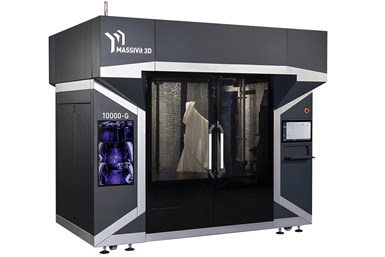Massivit 3D Expands Systems, Materials Portfolio to Automate, Speed Up Composite Production
Formnext 2022: These additive manufacturing systems utilize the company’s Cast In Motion technology, which is said to enable direct printing of complex molds using high-performance casting materials.
Share
Read Next
The Massivit 10000-G offers a full range of composite manufacturing applications. Photo Credit: Massivit 3D
Massivit 3D, a provider of large-scale 3D printing systems, has added the Massivit 10000-G to its flagship Massivit 10000 line of composite manufacturing systems. These additive manufacturing (AM) systems are designed to automate and speed up mold production for composite manufacturing.
Based on the company’s Cast In Motion technology, the Massivit 10000 facilitates digital production of complex molds, mandrels, master tools, jigs and fixtures for a range of industries, including automotive, rail, marine, defense, bath ware and sporting goods. It is said the system significantly expedites conventional mold production processes by directly casting industrial molds in a matter of days. It also brings to market the first isotropic, 3D-printed mold.
The Massivit 10000-G, the latest addition to the Cast In Motion product line, offers a full range of composite manufacturing applications available on the Massivit 10000, plus a new feature providing access to Massivit 3D’s set of Dimengel photo polymer materials that have until now been used with the company’s Gel Dispensing Printing product line. This feature enables Massivit 3D customers to markedly expand their business services to include direct custom manufacturing and functional prototyping.
The 10000-G also enables tooling applications for thermoforming, resin transfer molding and reaction injection molding. In addition, Dimengel materials respond to essential industry requirements such as flame retardancy, high-definition production and waste reduction.
In addition, Massivit 3D also offers a new, high-impact 3D printing material, Dimengel 400. The company says this material is the strongest and toughest of the company’s Dimengel thermoset photopolymers to date, making it well suited for the production of large, strong and stiff end parts as well as functional prototypes, jigs and fixtures. It is said to offer exceptional mechanical properties, including double the impact resistance of existing high-performance Dimengel materials, as well as a high Heat Deflection Temperature (HDT), enabling production of large parts that can withstand elevated temperatures. Dimengel 400 will be available with both of the company’s production lines.
“We are excited to introduce our latest large-scale 3D printing technologies designed to accelerate digital transformation in the manufacturing market. In particular, the composite manufacturing arena is steeped in labor-intensive and costly processes that are long overdue for innovation,” says Erez Zimerman, Massivit 3D CEO. “Our aim is to facilitate far more efficient processes using industrial-grade materials to maximize the true potential of composite materials.”
-
Learn how Massivit 3D’s additive tooling system utilizes the company’s Cast In Motion technology to enable direct printing of complex molds using high-performance casting materials.
- Massivit 3D designed the Massivit 5000 to dramatically expedite large-scale manufacturing, prototyping and tooling for the automotive, marine and rail industries.
Related Content
-
DMG MORI: Build Plate “Pucks” Cut Postprocessing Time by 80%
For spinal implants and other small 3D printed parts made through laser powder bed fusion, separate clampable units resting within the build plate provide for easy transfer to a CNC lathe.
-
Savage Automation Delivers 3D Printed Commercial Manufacturing Aids
The company's approach to designing end-of-arm tooling and other devices has evolved over the years to support longevity and repairs.
-
BMW Expands Use of Additive Manufacturing to Foster Production Innovations
The BMW Group is manufacturing many work aids and tools for its own production system using various 3D printing processes, with items such as tailor-made orthoses for employees, teaching and production aids, and large, weight-optimized robot grippers, which are used for such things as carbon fiber-reinforced polymer roofs and entire floor assemblies.















